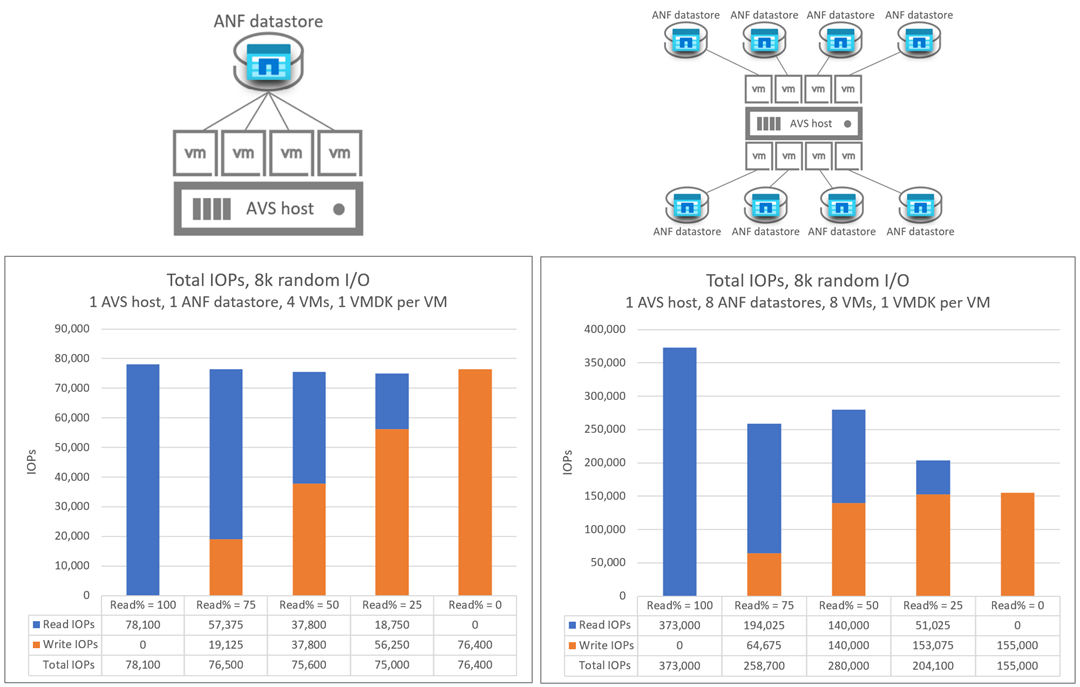Azure NetApp Files datastore performance benchmarks for Azure VMware Solution
This article describes performance benchmarks that Azure NetApp Files datastores deliver for virtual machines on Azure VMware Solution (AVS).
The tested scenarios are as follows:
- One-to-multiple virtual machines running on a single AVS host and a single Azure NetApp Files datastore
- One-to-multiple Azure NetApp Files datastores with a single AVS host
- Scale-out Azure NetApp Files datastores with multiple AVS hosts
The following read:write I/O ratios were tested for each scenario: 100:0, 75:25, 50:50, 25:75, 0:100
Benchmarks documented in this article were performed with sufficient volume throughput to prevent soft limits from affecting performance. Benchmarks can be achieved with Azure NetApp Files Premium and Ultra service levels, and in some cases with Standard service level. For more information on volume throughput, see Performance considerations for Azure NetApp Files.
Refer to the Azure NetApp Files datastore for Azure VMware Solution TCO Estimator to understand the sizing and associated cost benefits of Azure NetApp Files datastores.
Environment details
The results in this article were achieved using the following environment configuration:
- Azure VMware Solution host size: AV36
- Azure VMware Solution private cloud connectivity: UltraPerformance gateway with FastPath
- Guest virtual machine(s): Ubuntu 21.04, 16 vCPU, 64 GB Memory
- Workload generator:
fio
Latency
Traffic latency from AVS to Azure NetApp Files datastores varies from sub-millisecond (for environments under minimal load) up to 2-3 milliseconds (for environments under medium to heavy load). The latency is potentially higher for environments that attempt to push beyond the throughput limits of various components. Latency and throughput may vary depending on several factors, including I/O size, read/write ratios, competing network traffic, and so on.
One-to-multiple virtual machines running on a single AVS host and a single Azure NetApp Files datastore
In a single AVS host scenario, the AVS to Azure NetApp Files datastore I/O occurs over a single network flow. The following graphs compare the throughput and IOPs of a single virtual machine with the aggregated throughput and IOPs of four virtual machines. In the subsequent scenarios, the number of network flows increases as more hosts and datastores are added.
One-to-multiple Azure NetApp Files datastores with a single AVS host
The following graphs compare the throughput of a single virtual machine on a single Azure NetApp Files datastore with the aggregated throughput of four Azure NetApp Files datastores. In both scenarios, each virtual machine has a VMDK on each Azure NetApp Files datastore.
The following graphs compare the IOPs of a single virtual machine on a single Azure NetApp Files datastore with the aggregated IOPs of eight Azure NetApp Files datastores. In both scenarios, each virtual machine has a VMDK on each Azure NetApp Files datastore.
Scale-out Azure NetApp Files datastores with multiple AVS hosts
The following graph shows the aggregated throughput and IOPs of 16 virtual machines distributed across four AVS hosts. There are four virtual machines per AVS host, each on a different Azure NetApp Files datastore.
Nearly identical results were achieved with a single virtual machine on each host with four VMDKs per virtual machine and each of those VMDKs on a separate datastore.
Next steps
Feedback
Coming soon: Throughout 2024 we will be phasing out GitHub Issues as the feedback mechanism for content and replacing it with a new feedback system. For more information see: https://aka.ms/ContentUserFeedback.
Submit and view feedback for



